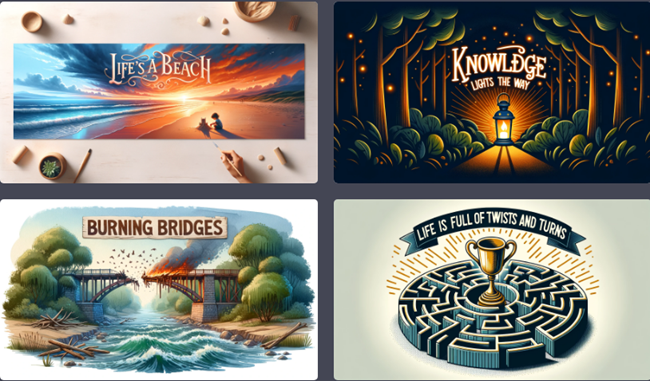Understanding Metaphors: Definition, Meaning & 10 Illustrative Examples

ejemplo de metafora
Metaphors are an integral part of our everyday language, adding depth and dimension to our words. They’re not just poetic devices; they shape our thoughts, our communication, and even our understanding of the world. But what exactly is a metaphor?
Also Read:- Indiana University’s IU Canvas: The Ultimate Guide to Online Learning & Resources
Metaphors: The Vivid Imagery of Language
Language is a powerful tool, capable of painting vivid images in our minds, evoking emotions, and connecting seemingly unrelated concepts. At the heart of this linguistic artistry lies the metaphor. A metaphor is more than just a figure of speech; it’s a lens through which we view and understand the world around us. By comparing one thing to another, metaphors create a bridge between the known and the unknown, the tangible and the abstract. For instance, when we say “time is money,” we aren’t literally equating the two, but rather emphasizing the value and fleeting nature of time. Such comparisons are not mere decorative elements of language; they shape our thoughts, perceptions, and even our actions. Metaphors are everywhere – in literature, daily conversations, advertisements, and even in scientific discourse.
They enrich our communications, making them more colorful, relatable, and impactful. As we delve deeper into the realm of metaphors, we’ll discover their intrinsic beauty, versatility, and the profound ways in which they influence our worldview.
What is a Metaphor?
A metaphor is a figure of speech in which a word or phrase is applied to an object or action to which it is not literally applicable. It’s a way of comparing two unrelated things without using “like” or “as,” which are used in similes. Instead, metaphors assert that one thing is another. For example, “Time is a thief.”
Metaphor Examples to Illuminate the Concept
- The world is a stage. This classic metaphor suggests that everyone has a role to play in the grand theater of life.
- Life is a roller coaster. Life has its ups and downs, much like the thrilling ride of a roller coaster.
- Her voice is music to his ears. Her voice brings as much joy as a beautiful song.
Diving Deeper: Metaphor Meanings
Let’s break down a metaphor to understand its meaning:
Example: “The heart of the room is the fireplace.”
Meaning: The fireplace is central and important to the room, much like the heart is to the body.
100 Quickfire Metaphor Examples
- Ideas are seeds.
- The classroom was a zoo.
- His words were cotton candy.
- She is the apple of my eye.
- Time is money.
- The world is a melting pot.
- Her smile is sunshine.
- The snow is a white blanket.
- America is a melting pot.
- His heart is a cold iron.
Metaphor Variations: 3, 6, and Meaningful Examples
Three Metaphor Examples:
- The stars are diamonds. Suggesting the brightness and value of stars.
- His temper is a volcano. Indicating a sudden and explosive anger.
- Hope is an anchor. Hope keeps us grounded and provides stability.
Six Metaphor Examples:
- Books are windows to the world. They offer a view into different realities.
- The car is a beast. Highlighting the car’s power and aggressiveness.
- Her laughter is a bubbling brook. Joyful, clear, and refreshing.
- His mind is a steel trap. Sharp, quick, and efficient.
- The city is a concrete jungle. Dense, wild, and challenging.
- The night was a velvet curtain. Soft, dark, and enveloping.
Example of a Metaphor and Its Meaning:
Metaphor: “The world is a book.”
Meaning: There’s so much to learn and discover in the world, just as there is in reading a book.
Conclusion
Metaphors enrich our language, allowing us to convey complex ideas with simple comparisons. They bridge the gap between the concrete and the abstract, making our communications more vivid and relatable. Whether you’re reading a novel, having a conversation, or trying to understand a new concept, metaphors are there, lighting the way and adding color to our words. So, the next time you come across a metaphor, take a moment to appreciate its beauty and depth. After all, life is a journey, and metaphors are the signposts along the way.
Metaphor FAQs
1. What is a metaphor?
A metaphor is a figure of speech that describes an object or action as something other than what it truly is.
2. How is a metaphor different from a simile?
While both compare two different things, metaphors say something “is” something else, while similes use “like” or “as.”
3. Can you give a simple metaphor example?
“Life is a journey.”
4. Are metaphors only used in literature?
No, metaphors are found in everyday language, music, advertisements, and even scientific discourse.
5. Why are metaphors important?
They add depth to language, making communication more vivid and relatable.
6. What’s a common metaphor for time?
“Time is money.”
7. Can a metaphor have more than two subjects?
Typically, a metaphor compares two things, but complex metaphors might involve more elements.
8. Are all metaphors universally understood?
No, some metaphors are culturally specific and might not be understood outside of that context.









